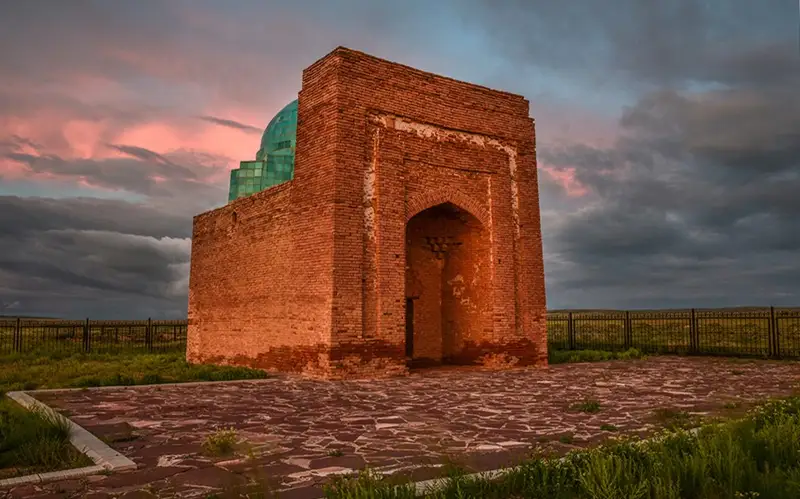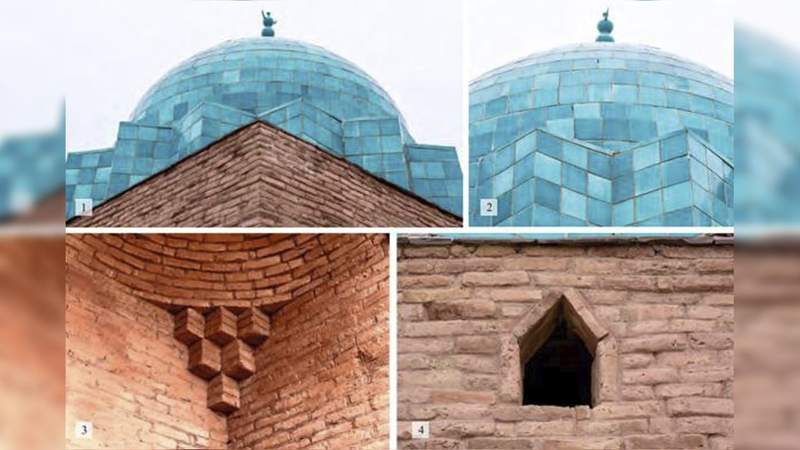Mausoleum of Jochi: theories and legends of Jochi's death
This year Kazakhstan is celebrating a significant event - the 800th anniversary of Ulus of Jochi. Kazinform News Agency offers to take a closer look at the mausoleum of Jochi Khan, as well as learn about his death and burial.

Mausoleum of Jochi Khan
The mausoleum of Jochi Khan was first mentioned in the notes of Hafiz Tanysh (XVI century). In 1982, it was included in the list of historical and cultural monuments of republican significance and is under state protection.
In 1946, an archaeological expedition led by Alkey Margulan discovered two burials in the mausoleum during excavations. According to scientists, one of them belongs to Jochi Khan, the other to his eldest wife Bektumysh.
Jochi's grave is located in the Ulytau region on the northern coast of the Kengir River, 45 kilometers from the city of Zhezkazgan. Oguz, Argyn, Kipchaks, Kerey, Naimans, Konyrat, Kanly and other tribes, which were once led by Jochi, took part in its construction.
The mausoleum has a portal-dome structure, dimensions in plan are 7.25 × 9.52 m, the height of the portal is 7.90 m, the building was erected from baked brick (26 × 29 × 5 cm). The mausoleum is covered with a dome with a double shell.

The outer dome has not been preserved; it used to rest on a star-shaped 17-sided drum of a very rare shape and was lined with tiles and turquoise glaze. The niche is covered with a semi-dome, resting on sails in the form of cellular stalactites made of brick. The inner shell of the dome, covering the square chamber, rests on arched sails.
In the depths of the chamber there is a tombstone. The floor of the mausoleum is paved with brick. The interior is illuminated by two arched openings located in the side chambers. Both the external volume and the interior are characterized by clarity and simplicity of composition.

Theories about the burial
The Jochi mausoleum has long been of interest among both historians and archaeologists. There are many theories and legends about whether this mausoleum really contains the remains of Jochi Khan. The bone remains from the burials inside the mausoleum have not yet been studied enough to make a definitive conclusion.
As stated in the collective monograph “Mausoleum of Jochi Khan: The History of Research”, historian Zardykhan Kiyanatuly in the book “Kazakh memleketi zhane Zhoshy Khan” (in 2004) noted:
“We cannot deny the possibility that Jochi Khan was buried in the Ulytau steppe, however, it is impossible to categorically state that the bones found in the first grave belong to Jochi, and in the second his wife Bektutmysh.”
One theory says that another person from the Golden Horde is buried in the mausoleum, and the grave of Jochi Khan itself is located nearby.
It is worth noting here that in accordance with Mongolian rituals, there was a tradition of secret burial. The burial of the ruling Mongolian elite took place in an atmosphere of strict secrecy, the burial place was carefully hidden. The secrecy of the burial guaranteed the preservation of the sacred charisma of the deceased leader, necessary for the favorable existence of the tribe.
Some scholars believe that Jochi's mausoleum is a Muslim burial structure, built later over the existing grave of Jochi. Thus, the main researcher and restorer of the monument in the 1990s, Elena Khorosh, expressed her opinion about the time of the initial construction of the Jochi Khan mausoleum:
...we join the consideration of the technical solution proposed by A.Kh. Margulan, the date for the construction of the Mausoleum in 1228 seems unrealistic; with the advent of an Islamic memorial and cult structure over the burial places of the Mongol khans and nobility, it was hardly possible before the adoption of Islam as the official religion in the Golden Horde. This question remains open and requires investigation.”
Other researchers are inclined to believe that the mausoleum is primarily of a memorial nature, and the remains of Jochi Khan himself are not buried there.
According to the assumption of the scientist Zh. E. Smailov, the construction of the mausoleum dates back to the 14th century, during the reign of Uzbek Khan, when Islam became the state religion of the Golden Horde. He also believes that since the burials in the mausoleum were performed according to a mixed rite, they also could not have been made earlier than the 14th century, and that the mausoleum was built by Uzbek Khan not over the burial of Zhoshy Khan, but in his honor.
Based on legends, it can be assumed that Jochi Khan’s body was not discovered after his death and he was not buried in the indicated mausoleum. Each legend, recorded over the years, tells the story of the disappearance of Jochi's body in its own way, which you can read about below.
Legends about the death of Jochi
The mausoleum of Jochi not only impresses with its architecture, but also preserves a rich folklore heritage. These legends are an important way to study the history of its creation and understand the cultural context. Kazakhs, Kyrgyz and Nogais have preserved legends about the death of the eldest son of Genghis Khan.
The archetype of folk legends about the death of Jochi Khan is the disappearance of the body after death.
The earliest Kazakh legend about the death of Jochi Khan was published on the pages of the weekly newspaper “Dala Ualatynyn Gazeti” in 1897. The legend was recorded by Otynshy Alzhanov (1873–1917) in the Atbasar district of the Akmola region among the Kazakhs of the “Baganaly” Naiman tribe. The text reads:
“One day, while hunting, he became so carried away by the pursuit of one kulan that he became far separated from his comrades. The pursued animal joined a large herd of grazing kulans. Jochi Khan began to shoot at them with a bow. The kulans, to his surprise, did not run away from him, but gathered in a heap. Jochi Khan kept firing arrow after arrow at them. The stricken animals fell one after another. But suddenly they, enraged, rushed at the merciless hunter and began to tear him with their teeth, trample him with their hooves, until only one little finger remained of the ill-fated Jochi Khan; the rest of his body was eaten by animals. The comrades rode in the footsteps of Jochi Khan to the scene of the event. No matter how hard they tried to collect the remains of the prince, they could not find anything except one little finger.”
Another legend says that Jochi’s entire body, except for the elbow, was eaten by kulans, or the animals destroyed only the elbow. In another version, Jochi’s father finds only one of his son’s thighs and erects a structure there for him.
